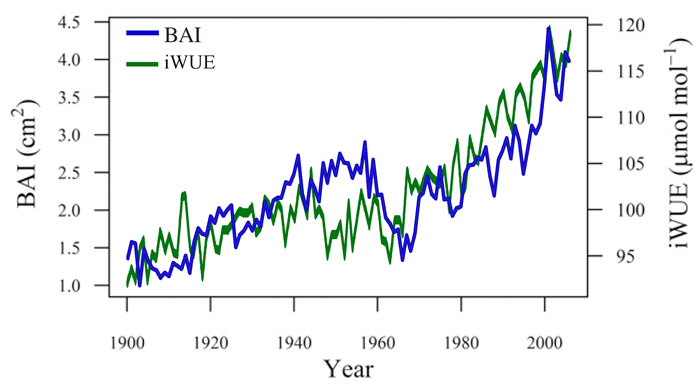| Follow @co2science |
Paper Reviewed
Huang, R., Zhu, H., Liu, X., Liang, E., Griebinger, J., Wu, G. Li, X and Bräuning, A. 2017. Does increasing intrinsic water use efficiency (iWUE) stimulate tree growth at natural alpine timberline on the southeastern Tibetan Plateau? Global and Planetary Change 148: 217-226.
Writing as background for their work, Huang et al. (2017) state that "forests play an important role in the global carbon cycle by absorbing atmospheric CO2 and storing it as carbon sinks," adding that it is "essential to understand how forests respond to the [rise in atmospheric CO2], since they can perform as a brake on the rate of rising atmospheric CO2 concentration and [postulated future] climate warming."
One way to gauge such a response is through examination of historical tree ring properties from natural or undisturbed forested regions. Over the past century or so, atmospheric CO2 concentrations have risen by 40%, which rise has provided a natural laboratory for not only ascertaining the relationship between CO2 and tree growth, but also for extrapolating that relationship into the future. Thus it was the goal of Huang et al. to examine the relationship between (1) two tree ring indices (basal area increment and intrinsic water use efficiency) derived from cores of Smith fir trees (Abies georgei var. smithii) growing at a high-elevation timberline site in the southeastern Tibetan Plateau), (2) rising atmospheric CO2 concentration and (3) climate, where it was their hypothesis that "if intrinsic water use efficiency ... has increased due to rising net photosynthetic rates under rising atmospheric CO2 concentration over the past century, tree growth should have benefitted." And what did their study reveal?
As illustrated in the figure below, intrinsic water use efficiency (iWUE) rose significantly by 27.83 percent over the period 1900 to 2006, which rise the authors report "is within the increase range observed around the world," and they cite numerous studies which they say "have confirmed the increasing trend of iWUE on a larger spatial scale." Additionally, Huang et al. report after conducting a series of statistical analyses on their data "that the increasing iWUE is mainly caused by the rising atmospheric CO2 concentration," and that "iWUE would continue to increase in the near future" given that the saturation level of photosynthesis has not yet been reached for Smith firs at the present-day atmospheric CO2 concentration.
With respect to basal area increment (BAI), Huang et al. note there has also been a strong increasing trend in this parameter over the past century and they similarly conclude that it is largely driven by the aerial fertilization effect of atmospheric CO2, being highly influenced in the short-term by interannual variations in temperature, where cooler temperatures can reverse the BAI trend (see, for example, the period from the late 1950s to 1960s). Huang et al. also report finding "a significant positive correlation (r = 0.79, p < 0.01) between BAI and iWUE," which they say indicates "that changes in iWUE and tree growth were likely to have had a common cause, i.e., the CO2 fertilization effect." Consequently, given the relationships between BAI, iWUE, CO2 fertilization and temperature, it is fairly easy to posit that in the future the growth of Smith fir trees near the timberline of the southeastern Tibetan Plateau will benefit from both rising temperatures and rising atmospheric CO2.

Figure 1. Basal area increment (BAI) and intrinsic water use efficiency (iWUE) derived from tree-rings obtained from Smith fir trees on the southeastern Tibetan Plateau. Adapted from Huang et al. (2017).




